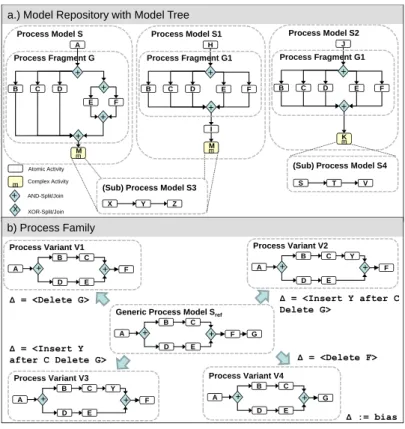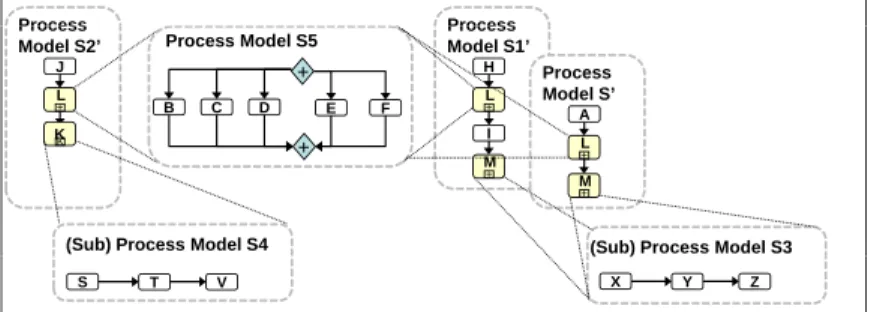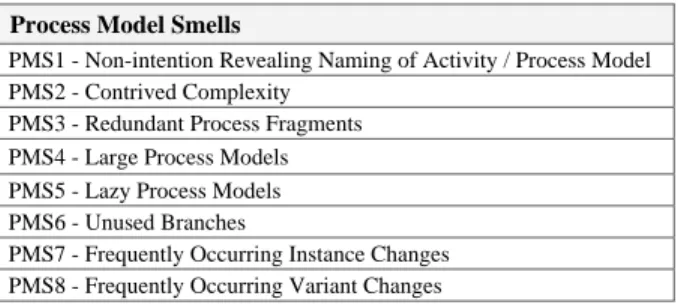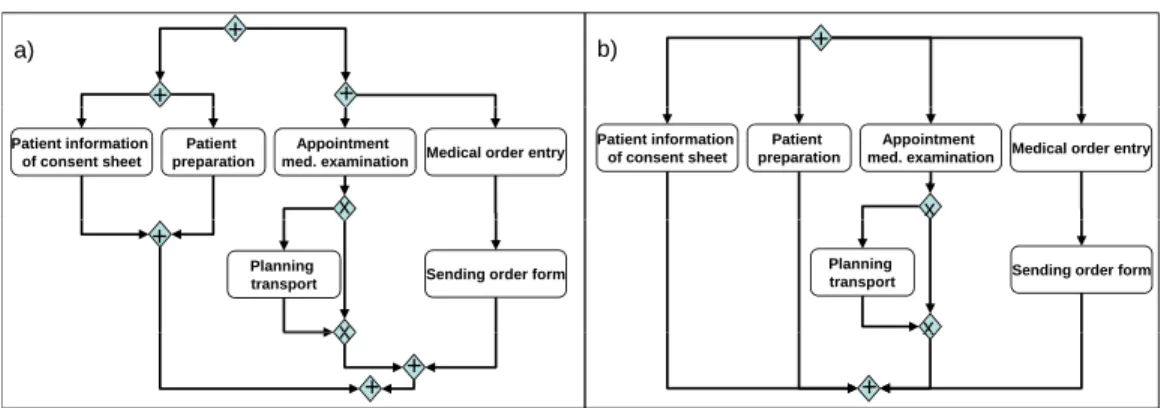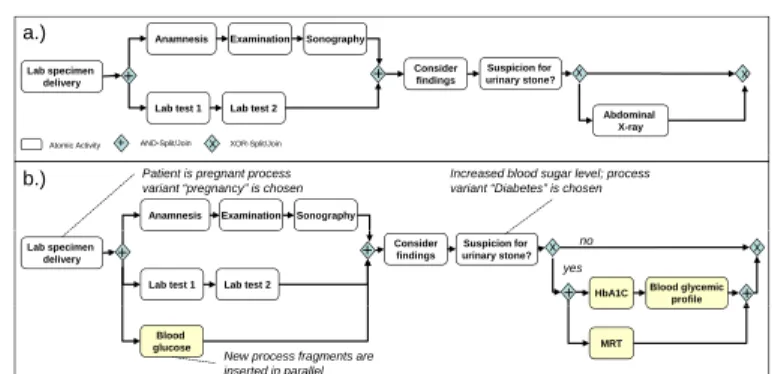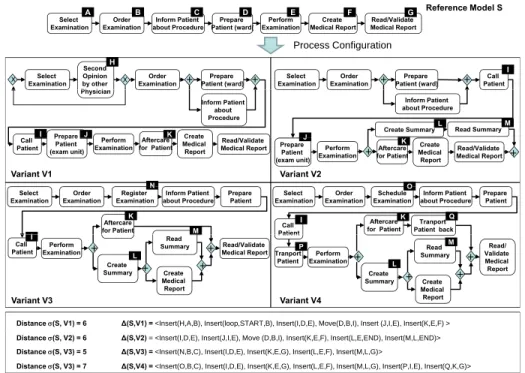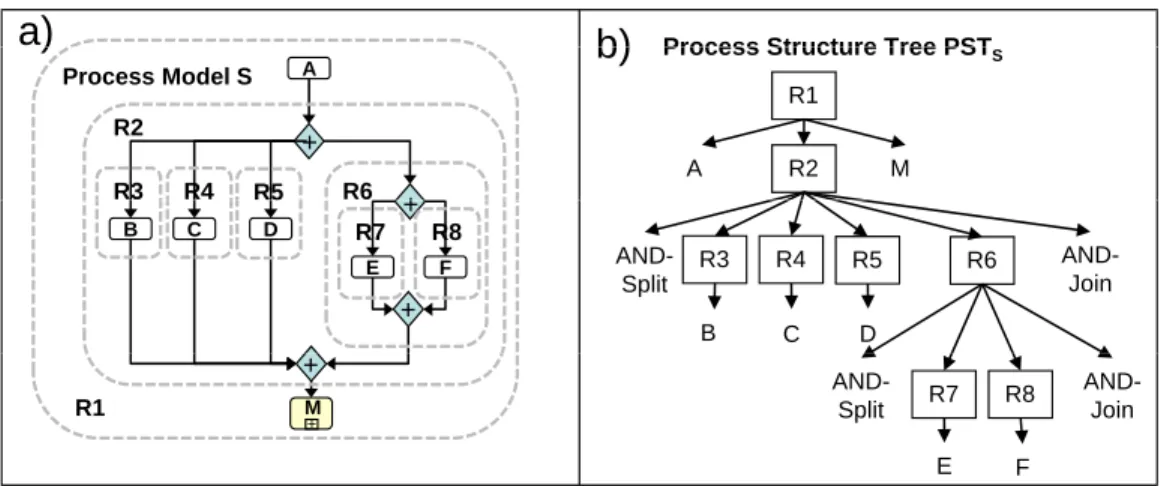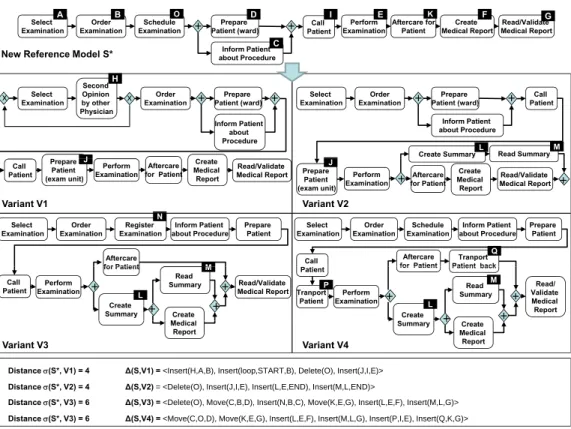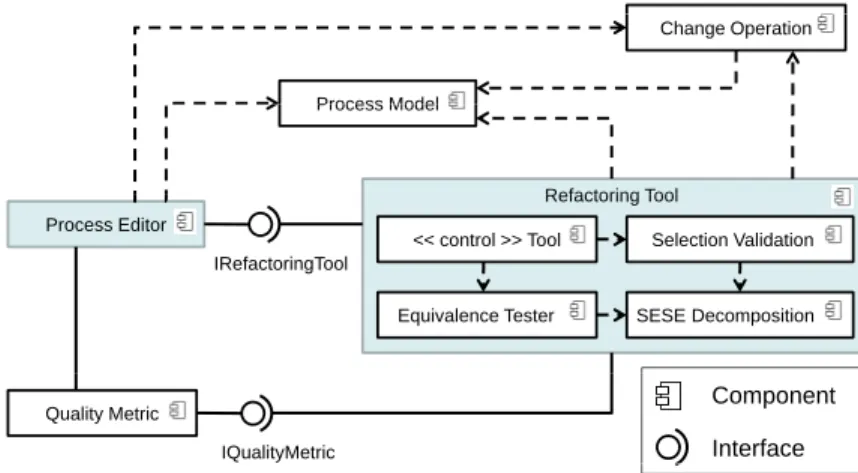Refactoring Large Process Model Repositories
Barbara Webera, Manfred Reichertb, Jan Mendlingc, Hajo A. Reijersd
aDepartment of Computer Science, University of Innsbruck, Austria
bInstitute of Databases and Information Systems, University of Ulm, Germany
cHumboldt-Universit¨at zu Berlin, Germany
dSchool of Industrial Engineering, Eindhoven University of Technology, The Netherlands
Abstract
With the increasing adoption of process-aware information systems, large process model repositories have emerged. Typically, the models in such repos- itories are re-aligned to real-world events and demands through adaptation on a day-to-day basis. This bears the risk of introducing model redundan- cies and of unnecessarily increasing model complexity. If no continuous in- vestment is made in keeping process models simple, changes will become more difficult and error-prone over time. Although refactoring techniques are widely used in software engineering to address similar problems, so far, no comparable state-of-the-art has evolved in the business process manage- ment domain. Process designers either have to refactor process models by hand or are simply unable to apply respective techniques at all. This paper proposes a catalogue of process model “smells” for identifying refactoring opportunities. In addition, it introduces a set of behavior-preserving tech- niques for refactoring large process repositories. The proposed refactorings enable process designers to effectively deal with model complexity by making process models better understandable and easier to maintain. The refactor- ings have been evaluated using large process repositories from the healthcare and automotive domain. To demonstrate the feasibility of the refactoring techniques, a proof-of-concept prototype has been implemented.
Key words: Process-aware Information System, Process Model Quality, Process Model Smell, Process Model Refactoring
Email address: Barbara.Weber@uibk.ac.at(Barbara Weber)
1. Introduction
Process-aware Information Systems (PAISs) have become an integral part of enterprise computing and are used to support business processes at an op- erational level [100]. In contrast to conventional information systems, PAISs strictly separate process logic from application code, relying on explicit pro- cess models that provide the schemes for process execution. This enables a separation of concerns, which is a well established principle in Computer Science to increase maintainability and to reduce costs of change [13].
1.1. Problem Statement
Process repositories are the central store of process models in PAISs. In large companies, such repositories can easily contain several thousands of process models [72]. Such sheer numbers give rise to several quality issues.
Over time new process models emerge, existing ones need to be adapted to changing requirements, and new process model variants are created to align processes to a particular context (e.g., specific regulations in one of the countries where the company operates). While support for model changes is quite well understood from a research perspective both in terms of process model configuration [74, 71] and adaptation of running process instances [58, 60], a notable research gap exists concerning quality assurance in process repositories.
This gap is underlined by two facts: First, regarding model construction companies try to delegate process modeling tasks to operational staff that has little or no modeling competence [72]. Thus, it is not surprising that process model repositories tend to contain a rate of unsound models that ranges from 3.3% up to 37.5% [40]. This rate is a severe roadblock to process model usage. Second, it is well known from software engineering research that computer programs degenerate over time when code is modified or added by different developers [54]. Since numerous users may work on a single pro- cess repository, we can expect that process repository evolution faces similar challenges as software program evolution does; i.e., maintenance will become increasingly difficult over time if no techniques for quality improvement are provided.
While methods and tool support are still limited in process modeling, there has been considerable progress in software engineering (SE) on related problems. So called refactoring techniques have been widely used to ensure
that code bases remain maintainable [52, 17]. Refactoring enables program- mers to restructure a software system without altering its behavior. Thus, it is typically used to improve code quality by removing duplication, improving readability, simplifying software design, or adding flexibility [2]. Examples of SE refactoring techniques include the renaming of a class to foster under- standability and the extraction of a new method from an existing code block to reduce redundant code fragments and to increase readability. In the SE domain, code smells are widely used for identifying refactoring opportunities [50] (e.g., duplicate code or very long methods).
It has been noted by various authors that process models and computer programs are similar in various respects [23, 90]. In [92], the following par- allels are singled out:
• Both types of artifacts provide a procedural view on the processing of information. Within each described step, either within a process model or a computer program, one or more outputs are produced on the basis of one or more inputs.
• A process model has acompositional structure that is similar to that of a computer program. A computer program can be split up into mod- ules or classes. Every module consists of a number of statements, and every statement references variables and constants. Likewise, a process model contains activities, each of these being composed of elementary operations, which in turn use one or more pieces of information to produce new information.
• Both a process model and a computer program can be used as script for enactment. When instantiating either of these, an execution flow of their elements is invoked that unfolds in accordance with this static representation. This flow may involve consecutive executions, concur- rency, conditional routings, etc.
Considering these similarities, it is not surprising that some authors even refer to process modeling as “programming in the large” [90]. Our line of reasoning now is that the idea of refactoring, well-known in the area of soft- ware engineering, may well be an attractive direction to investigate in the context of process model usage in PAISs.
1.2. Contribution
This article adapts the concept of refactoring from SE to process model- ing. Our contribution is twofold. Firstly, we provide an extensive discussion of process model smells facilitating the identification of refactoring opportu- nities. Secondly, we introduce refactoring techniques that provide remedies for these smells. A refactoring technique improves upon the internal quality of a model such that it becomes easier to read and maintain, but it does not affect the model’s semantics or external behavior. The techniques are pro- posed as a means to assist process designers, but the final decision whether or not to apply a refactoring in a specific situation is always at their discretion.
In that sense, the proposed refactoring techniques support a modeler’s task without making it superfluous.
The presented smells and refactorings are not complete in a mathematical sense: It can be easily imagined that refactorings might be added in future or that existing refactorings will be refined. The presented list, however, is duly empirically validated on utility considerations. Using a range of existing process repositories from the healthcare and automotive domain, we are able to show that all identified refactorings are frequently needed in practice. A similar argument of relevance is also used in SE as constructive criterion for design patterns [18]. Beyond that, we provide a second constructive validation in terms of a prototypical implementation, which demonstrates how the different refactorings can be offered to process designers in an easy- to-use fashion.
While some isolated refactorings are discussed in [15], our contribution is the first comprehensive account of the refactoring concept for process models.
At the same time, process models typically comprise different perspectives including control-flow, data flow, and resource allocation. Our contribution is restricted in the sense that it purely focuses on the control-flow perspective.
This is, however, not a fundamental limit: It can be imagined how the current set of refactorings can be extended to cover other dimensions as well.
With respect to previous work, our paper significantly extends the ap- proach presented in [95] where various refactoring techniques were intro- duced. The extensions cover (a) the introduction of a catalogue of process model smells facilitating the detection of refactoring opportunities, (b) the evaluation of the refactorings based on both empirical data from the health- care and the automotive domain and the existing literature, and (c) a demon- stration of the applicability of the refactorings based on a proof-of-concept implementation.
This paper further complements previous work on process redesign and process adaptation. Both refactoring andprocess redesignmay require model transformations. However, the scope of process redesign is broader and goes beyond structural adaptations. It is primarily business-driven and aims to improve one or more performance dimensions of a process (e.g., time, quality, costs) [61]. Therefore, redesign often affects the external quality of a PAIS and its results are visible to the customer. In contrast, refactoring techniques primarily impact the internal quality of a PAIS, ensure conceptual integrity, and foster maintainability. Similar to refactorings, process adaptations [58, 60, 98] refer to structural changes of a process model (e.g., using change patterns) [96]. In contrast to refactorings, they usually affect process model behavior.
The paper is structured as follows. Section 2 presents a generic meta model we assume for a process repository. We use an illustrative example to introduce process modeling as well as refactoring concepts. We then define the scope of the process model refactorings we consider. Section 3 presents a set of empirically supported process model smells for detecting refactor- ing opportunities. Section 4 describes 11 refactoring techniques which en- able process designers to improve the quality of process models and provide remedies for the process model smells as discussed in Section 3. Section 5 demonstrates the applicability of the refactorings based on a prototypical implementation and provides a realistic use scenario. Section 6 discusses related work, before Section 7 concludes the paper.
2. Preliminaries
We first introduce general concepts providing the foundation of this paper.
Section 2.1 presents the meta model we assume for a process repository.
Section 2.2 defines refactoring and aligns it to process modeling concepts.
2.1. Process Repository Meta Model
The most essential entities in a process repository are process models.
Severalprocess modeling languages have been defined including Event-driven Process Chains (EPCs), Business Process Modeling Notation (BPMN), and Workflow Nets. They have distinctive elements and sometimes display sub- tle differences in semantics. In the following, we aim to abstract from these differences, and focus on basic commonalities of these languages instead [84].
Accordingly, we define a process model as a set of activities and gateways
that are connected by control-flow arcs. Gateways can be either split nodes (i.e., nodes with one incoming and multiple outgoing arcs) or join gateways (i.e., nodes with multiple incoming and one outgoing arc). There are three different types of splits and joins. The XOR-split defines a decision point where one outgoing branch becomes activated and the XOR-join the respec- tive merge. The AND-split introduces concurrent processing of all outgoing branches while the AND-join synchronizes its incoming branches. The OR- split represents a non-exclusive choice in the sense that one, multiple, or all outgoing arcs can be activated. The OR-join guarantees proper synchroniza- tion of those branches that have become active.
There are relationships that span different process models as well. Most relevant is the subprocess relationship that refers from an activity of one process model (parent) to another process model as a whole (child). This signifies that the subprocess implements the activity, i.e., every time the activity gets activated, it is the subprocess that has to be executed. We denote such an activity as a complex activity. We require the parent-child process relationship to be acyclic such that we have different process model trees linking parent and child process models. Subprocesses constitute a powerful concept for describing the common parts of different process models.
Fig. 1a illustrates the content of a very simple process repository at a certain point in time. There are five process models S, S1,S2, S3, and S4.
Model S includes an AND-split after activity A. Accordingly, B, C and D, and also E and F can be executed concurrently. The AND-join synchronizes the different paths. M is a complex activity pointing to subprocess S3 that executes activity sequence X,Y andZ. Model S1 uses this subprocess as well.
S1 and S2 also contain the same process fragment, which is built upon an AND-split and AND-join. Finally,S2 contains complex activityKthat refers to S4. As can be seen, parts of the different models are redundant in the sense that they cover exactly the same process logic.
Process models can either be created from scratch or through adaptation of areference process model, i.e., by means of configuration. From such a ref- erence model Sref, several process model variants V1. . . V n can be derived based on a restricted set of high-level change patterns [58, 96].1 Thereby, for a given variant model V we denote the minimal number of high-level
1Examples of change patterns include the insertion, deletion and movement of activities within a process model.
Process Model S
a.) Model Repository with Model Tree
A Process Fragment G
Process Model S1 H Process Fragment G1
Process Model S2 J Process Fragment G1
+ + +
B C D +
E F
Process Fragment G
B C D E F
Process Fragment G1
+ +
B C D E F
Process Fragment G1
K+ M M
+ +
+ +
I
(Sub) Process Model S4
XOR-Split/Join AND-Split/Join Atomic Activity
+ Complex Activity
+ x
(Sub) Process Model S3
X Y Z
(Sub) Process Model S4
S T V
b) Process Family
+ +
Process Variant V1 A
C F B
+ +
Process Variant V2 A
C
F
B Y
Generic Process Model Sref C B +
A
E F D
Δ = <Delete G>
E D
Δ = <Insert Y after C Delete G>
+ +
A
C
E F B
D
G
Process Variant V4
Δ = <Delete F>
Process Variant V3 Δ = <Insert Y after C Delete G>
+ +
Process Variant V4 A
C
E G B
D
+ +
Process Variant V3 A
C
E
F B
D Y
Δ:= bias
Figure 1: Core Concepts
changes needed to transform the reference model Sref into V as change dis- tance σ(Sref, V) between Sref and V. Furthermore, a minimal sequence of high-level changes needed to transform model Sref intoV is denoted as bias (∆) between Sref and V.2 The total set of all variant models (i.e., variants for short) derived from a reference process is called a process model family.
Fig. 1b shows a reference process model Sref and four process variants V1, . . . , V4 derived from it; e.g., to configureSref into V2 we need to insert Y and delete Activity G; i.e., we obtain distance σ(Sref, V2) = 2 and bias
∆(Sref, V2) = [Insert Y after C, Delete G].
Based on a given process model, at run-time new process instances can
2Generally, it is possible to have more than one minimal sequence of change operations to transform Sref into V, i.e., given two process models their bias does not need to be unique (see [36] for a detailed discussion on this).
be created and executed according to this model. The latter is reflected by the execution traces of these instances, which log information about events relating to the start and completion of process activities [85].
2.2. Process Models and Refactorings
The term “refactoring” was coined by Opdyke [52] and refers to “the process of changing a software system in such a way that it does not al- ter the external behavior of the code, yet improves its internal structure”
[17]. As such, refactoring neither resolves errors nor adds functionality, but improves understandability and maintainability through behavior-preserving model transformations. Therefore, refactoring differs from model transfor- mations applied when redesigning or adapting processes, since these transfor- mations are typically not behavior preserving. Refactoring can be classified as bothendogenous (i.e., transformations between models expressed in same language) and horizontal (i.e., source and target model reside at same level of abstraction) [49]. Refactorings constitute small changes with little value when applied in isolation, but these become valuable when combined with other refactorings [2]. Thus, model refactoring constitutes an iterative pro- cess which enables designers to improve the quality of a process repository.
According to [50] we define refactoring by a procedure consisting of a number of distinct activities:
1. Identify refactoring opportunities
2. Determine which refactoring(s) shall be applied
3. Ensure that the applied refactoring(s) preserve model behavior 4. Apply the refactoring
5. Assess the effect of the refactoring on quality characteristics of the process model repository (e.g., understandability, maintainability)
In SE, the incentive to consider a particular refactoring is the detection of a code smell [17]. Code smells are indicators of bad code quality and in our application domain of bad process model quality. Let us revisit our process repository from Fig. 1a to illustrate this point. We have already stated that the repository contains several redundancies. Using “refactoring terms” we can now describe these asprocess model smells: modelsS1 andS2 both include the common process fragment3 G1, which is a slight variation
3In the context of this paper a (process) fragment denotes a subgraph of a process model with single-entry and single-exit node.
of process fragment G contained in the left model S (i.e., although process fragments G and G1 are not structurally equivalent, they expose the same behavior). Using refactoring techniques, we can extract these commonalities from the different models (cf. Fig. 2). This results in a new modelS5, which represents the logic of process fragment G1 and G, respectively, and which becomes a subprocess of the refactored models S, S1, and S2. Due to the reduced redundancy, the resulting process models should now be easier to maintain, but still expose the same behavior.
Whether the occurrence of a smell really means that a model must be refactored is not a black or white decision. The value of a particular refac- toring often involves the trade-off between different quality characteristics.
For example, extracting (redundant) process fragments from one or several process models decreases the overall model size on the one hand, but poten- tially increases the number of process models (with low number of activities).
This aspect is captured in our approach that aims to assist the process de- signer rather than to fully automate the refactoring process.
a) Model Repository before Refactoring
Process Model S A
Process Model S1 H
Process Model S2 J
+ +
B C D +
E F
G
B C D E F
G1
+
B C D E F
G1
K+ M
+
M
+ +
+
E F
+ I
+
+
XOR S lit/J i AND-Split/Join Atomic Activity
+ Complex Activity
+ x
(Sub) Process Model S3
X Y Z
(Sub) Process Model S4
S T V
Process Process
XOR-Split/Join
x
+
B C D E F
Process Model S5
L + J Process Model S2’
L + H
I Process Model S1’
L A Process Model S’
KK
+
M+ L + M +
(Sub) Process Model S3
K
(Sub) Process Model S4 ( )
X Y Z
S T V
Figure 2: Model Repository after Refactoring (cf. Fig. 1a)
In the following, we approach process model refactorings from two angles, and with reference to the five refactoring steps as summarized above. First, we explain how refactoring opportunities can be identified. In this context, we introduce a catalogue of process model smells that signal low process model quality. The guidelines are supported both by an empirical evaluation and a study of the relevant literature. Thereby, we assume that process designers determine – in the same spirit as software engineers do for code refactorings – whether or not a refactoring shall be applied taking various trade-offs into account. Second, we describe a set of behavior-preserving refactoring techniques which can be used to improve overall quality of the
process model repository without changing actual process behvior. Again we assume that process designers assess the effect of the applied refactoring.
3. Identifying Refactoring Opportunities
In the SE domain code smells are the most popular method for identi- fying refactoring opportunities [50]. Picking up this metaphor, Section 3.2 introduces a list ofprocess model smells serving as indicators for low process model quality. These smells were identified based on a large collection of pro- cess models from different domains (cf. Fig. 3). Such an empirical approach seems justified given the lack of an established theory that captures how modeling artifacts come into being. Additional support was gathered from a literature study that focuses on the understandability and maintainability of process models (cf. Section 3.1). Section 3.3 summarizes our results on process model smells.
3.1. Research Methodology
We first describe the selection criteria for our process model smells, the data sources providing the empirical evidence for them, and the procedure we applied for their identification.
3.1.1. Selection Criteria
We consider process model smells for assisting designers in detecting op- portunities for process model refactoring. Our focus is on smells which can be addressed bybehavior-preserving refactoring techniques; i.e., our refactor- ings do not change the actual behavior of the process models to which they are applied. In addition, the smells should not be restricted to a specific process modeling language.
3.1.2. Data Sources and Data Collection
The following collections of process models have been used as sources for the identification of process smells (cf. Fig. 3 for an overview). The data sources were carefully selected to cover processes from several domains (i.e., healthcare and automotive engineering) and to mitigate the risk that the identified process model smells are specific for a particular domain. Moreover, we ensured that the selected data sources comprise processes with different characteristics. The process models range from very small ones (with just a few activities) to very large models (with hundreds of activities). The
sources include single process models, but also families of process models expressed in different process modeling languages. Finally, the selection of data sources also considered aspects like the presence of a sufficiently large number of models and full access to the respective process model repository.
Smell Sources Literature Metrics Refactorings PMS1 1-7 [41,43,46,77,78] verb-object style RF1, RF2, RF7 PMS2 1-7 [1,8,9,42,48,88,90,91] cyclomatic number, structuredness,
density, structural appropriateness
RF3
PMS3 1, 4, 5, 6 [3,89] footprint similarity RF4, RF5, RF8
PMS4 5 [42,44,48,63] size RF4
PMS5 6 [63,77] #activities / subprocess RF6 PMS6 2, 3, 7 [75,83] behavorial appropriateness RF10
PMS7 3 [51,97] #instance changes RF11
PMS8 4, 6, 7 [35,37,62] change distance RF9
Data Source
Domain Scenarios Number of
Models
Reference Source 1 Healthcare Birth and postnatal care
Inpatient chemotherapy treatment Outpatient chemotherapy treatment Ovarian carcinoma surgery Keyhole surgery
70 process models [59]
Source 2 Healthcare Clinical guidelines and pathways in internal medicine
46 process models Source 3 Healthcare Clinical guidelines for urinary stone
diagnosis
1 process model with 98 instances Source 4 Healthcare Handling of medical procedures (i.e.,
requesting, scheduling, performing and validating medical examinations)
84 process model variants
Source 5 Automotive Vehicle development 1 process model [6]
Source 6 Automotive Electronic change management 60 process models [19]
Source 7 Automotive Vehicle repair 900 variants [24]
Smell Literature Metrics Refactorings
PMS1 [27-32] verb-object style RF1, RF2, RF7 PMS3 [44-46] footprint similarity RF4, RF5, RF8
PMS4 [39,40,48,49] size RF4
Before Refactoring Refactorings After Refactoring
PMS1 – 1 violation of verb-object style RF1 (1x) All activities labeled according to verb-object style
PMS3 – Fragments 1 and 2 are redundant RF4 (1x) RF5 (1x)
No redundant fragments Reduction of model size by 8 PMS4 – Process model with 42 nodes
(22 activities, 18 gateways, 1 start node, 1 end node)
RF4 (4x) Flight Schema (S1): size 12
Preflight Process Schema (S2): size 7 Clearance Process Schema (S3): size 6 Taxiing Process Schema (S4): size 9 Take-Off Process Schema (S5): size 8 Repair Process Schema (S6): size 11 Figure 3: Data Sources for Identifying Process Smells
Source 1. In a large healthcare project we analyzed five core processes of a women’s clinic as documented in its organizational manual: birth and postnatal care, inpatient chemotherapy treatment, outpatient chemotherapy treatment, ovarian carcinoma surgery, and keyhole surgery [59]. In total, these five core processes consist of 70 process models, which are expressed either in terms of Event Process Chains or UML Activity Diagrams. Each process model contains 2 to 18 activities.
Source 2 comprises 46 process models (with up to 40 activities) repre- senting medical guidelines and clinical pathways in internal medicine.
Source 3 consists of a clinical guideline for urinary stone diagnosis as implemented in a PAIS (1 process model with 98 process instances).
Source 4 comprises process models from a clinical center, i.e., 84 process model variants with 7 to 17 activities for the handling of medical procedures;
i.e., activities for requesting, scheduling and performing medical examina- tions as well as for validating their results.
Source 5 is a core process in vehicle development: product planning [6].
The process model (plotted on a 1,5m x 5m wallpaper) comprises several
hundreds of activities for planning production facilities and resources with complex inter-dependencies, and the flow of about 50 relevant documents.
Further, there exists a process handbook with detailed activity descriptions.
Source 6 refers to a case study on electronic change management (ECM) from the automotive industry. ECM process models were partially published by the German Automotive Industry [19]. Our material comprises 60 process models expressed in different notations like Event Process Chains and UML Activity Diagrams (with 2 to 32 activities).
Source 7 is a vehicle repair process from the automotive domain [24].
Overall, there exist around 900 variants of this process, 68 of which are documented in explicit process models (in a BPMN-like language).
3.1.3. Procedure for Process Model Smell Identification.
We first created a list of candidate process smells by taking an existing list of code smells from the SE domain as starting point [17]. Since the focus of this paper is on the control-flow perspective, we only considered smells which are related to this perspective. In addition, we used the outcomes of an extensive literature study to support the importance of the proposed smells and to underline that the process model smells are really indicators of bad model quality. Next we thoroughly analyzed the above mentioned material to find empirical evidence for our process model smells and – if necessary – extended the candidate list of process model smells. Since we want our process model smells to help detecting common quality problems in process models, we required each of the smells to be observed at least three times in the different models from our sources. Therefore, only those smells, for which enough empirical evidence exists, are included in the final list of process model smells.
3.2. Process Model Smells
In the following we present the identified process model smells (cf. Fig. 4).
Each smell is briefly described and then illustrated using material from the aforementioned data sources.4 We subsequently discuss each smell along its supporting literature, also explicitly addressing related process model quality metrics. Forward references are provided to the refactoring techniques in Section 4 that can be used to address the respective smells.
4Even though we illustrate each smell by way of an example, we have observed it multiple times when analyzing the numerous process models from our data sources.
RF3: Substitute Process Fragment RF4: Extract Process Fragment
RF5: Replace Process Fragment by Reference RF6: Inline Process Fragment
RF7: Re-label Collection RF8: Remove Redundancies RF9: Generalize Variant Changes RF10: Remove Unused Branches RF11: Pull Up Instance Change
Process Model Smells
PMS1 - Non-intention Revealing Naming of Activity / Process Model PMS2 - Contrived Complexity
PMS3 - Redundant Process Fragments PMS4 - Large Process Models PMS5 - Lazy Process Models PMS6 - Unused Branches
PMS7 - Frequently Occurring Instance Changes PMS8 - Frequently Occurring Variant Changes
Figure 4: Catalogue of Process Model Smells
3.2.1. PMS1: Non-intention Revealing Naming of Activity / Process Model.
Description. Activities in a process model are normally tagged with textual labels. However, improper labels may not reveal the intended content or purpose to readers. This makes the model more difficult to understand.
Illustration. When analyzing the 70 process models from Source 1 we identified significant inconsistencies regarding activity names and labeling styles. For example, 16 process models contained activities dealing with the scheduling of medical procedures (e.g., surgeries, medical examinations, drug administrations). Although all these activities had similar intentions, different labels and labeling styles were used (e.g., “make appointment”, “ap- pointment”, “schedule examination”, “fix day”, “agree on surgery date”, and
“plan”). This, in turn, caused considerable efforts when reusing the models later in the context of a large harmonization project (see the illustration of the “Lazy Process Models” smell in Section 3.2.5).
Discussion. In literature, many guidelines exist stressing the importance of appropriate activity namings in process models [77, 39, 78]. Furthermore, em- pirical evidence exists that negative effects can occur if inappropriate labels are used. In an experimental study [41, 43] the impact of different grammat- ical styles for activity labeling was investigated. When being asked to single out the labels in a process model that were ambiguous, respondents often referred to labels that didnot first mention a verb, followed by an object. In contrast, labels that followed this “verb-object” style (e.g., Determine Loan Conditions) were rated as being significantly more useful. In addition,length of a text label can be an issue, as was established in another experiment [46].
While activities not following the “verb-object” style can be automatically detected [34], non-intention revealing labels have to be manually identified
by process designers.
Relevant Refactorings. RF1 (Rename Activity), RF2 (Rename Process Model), RF7 (Re-label Collection)
3.2.2. PMS2: Contrived Complexity
Description. It is often possible to express a piece of control-flow logic within a process model in different ways. However, one alternative may be more difficult to comprehend for humans than another, despite their equiva- lence with respect to the (partial) execution traces they produce. Using the more complex alternative may negatively affect model understanding, and thus make maintenance of the model more difficult.
Illustration. In the model repositories from all considered data sources we were able to identify process models with unnecessarily complex control-flow structures, which could be simplified without changing the models’ behav- ior. Examples of such complications include unnecessary AND-splits/-joins in connection with parallel branchings and superfluous control arcs express- ing order relations that could be transitively derived by a set of other control arcs. Fig. 5a gives an example of unnecessary logical connectors; its simplified version is shown in Fig. 5b. It is worth mentioning that another factor im- pacting the difficulty humans had in respect to the comprehension of process models in the considered sources concerns the layout of the process model.
+ +
+ +
+
Patient information of consent sheet
Patient preparation
Appointment
med. examination Medical order entry
1 2 3 4
x
Patient information of consent sheet
Patient preparation
Appointment
med. examination Medical order entry
1 2 3 4
x
x
Planning
transport Sending order form
5 6
+
x
Planning
transport Sending order form
5 6
x
x + +
x +
a) + b) +
+ +
Patient information of consent sheet
Patient preparation
Appointment
med. examination Medical order entry
x
Patient information of consent sheet
Patient preparation
Appointment
med. examination Medical order entry
x
x
Planning
transport Sending order form
+
x
Planning
transport Sending order form
x + +
x +
Figure 5: Process Fragment from Healthcare Case
Discussion. Various studies have investigated the impact of structural model properties on model understandability. For example, [9] is centered around an adaptation of the cyclomatic number (one of the most widely
used SE metrics) for business processes. Other research has analyzed process model understandability as aspect of maintainability, and has identified sev- eral correlations [8, 1]. Further metrics take their motivation from cognitive research [91] or are based on concepts of modularity [93, 88]. Most notably, an extensive set of metrics has been validated as factor influencing both error probability [48] and understandability [42]. The various validations show that factors like structuredness of a process model (i.e., the proper nesting of its gateways) and its density (i.e., the number of connections between its model elements) are influential. Both aspects can be manipulated by restructuring a process model; e.g., [91] presents three different, but trace-equivalent process models displaying different degrees of connectivity between model elements.
Similarly, [75] proposes a metric for structural appropriateness, which can be used to determine how different models compare in their ability to capture a process in a compact and meaningful way.
Relevant Refactoring. RF3 (Substitute Process Fragment) 3.2.3. PMS3: Redundant Process Fragments
Description. Both within a single and across different process models, there may be fragments capturing the same control-flow logic. Whenever it is required to change this logic (e.g. due to changes in regulation or policy), the change must be propagated across all these occurrences. When overlooking some of them or when applying any of the changes incorrectly, inconsistencies arise which make successive maintenance even more problematic.
Illustration. Source 1 comprises 70 process models of a women’s clinic. De- spite their diversity the models contained many redundant fragments, which in most cases covered repetitive procedures relevant in a more general con- text. Examples include patient admission and discharge, medical reporting, and medical order handling (e.g., ordering drugs or a medical examination).
Discussions with process owners showed that redundancies had been par- tially introduced through copying and pasting fragments from existing models when defining new ones. Furthermore, over time these cross-model redun- dancies led to problems in model maintenance due to oversized models as well as model inconsistencies.
Discussion. A common reason for redundancies entering process models is that multiple model variants are created for different scenarios [73]. Process parts may then be applied in a copy-paste fashion, which is indeed also the case for the illustration we provided above. As a consequence, even simple changes might require manual re-editing of process variants [35]. Accordingly,
the advice to avoid redundancy in process models is widespread [3, 29]. For example, [29] extracts typical modeling errors analyzing hundreds of process models. The researchers suggest that each activity, whenever possible, should only be defined once and be made available in some sort of global repository to avoid execution errors and to improve model understandability. In [89]
the footprint similarity metric is proposed to detect highly similar process models or process model parts, which can be used to detect this smell.
Relevant Refactorings. RF4 (Extract Process Fragment), RF5 (Replace Process Fragment by Reference), RF8 (Remove Redundancies)
3.2.4. PMS4: Large Process Models
Description. With an increasing number of activities process models be- come more difficult to understand and maintain.
Illustration. The product planning process from Source 5 comprises several hundreds of activities for planning production facilities. Interviews with pro- cess owners revealed that the current model contains several flaws, is known in its entirety to only very few experts, and is partially outdated. Moreover, the model is considered as being too large and difficult to maintain.
Discussion. Beyond the sources available to us, various instances of process models that have grown to a very large size have been recorded in literature.
For example, the model in [79] initially consisted of more than 800 activities, but this number grew with 17% in an observed time period of two years.
Even though it is natural for process models to grow in size along with their increased use, it is by now well-known that size of a process model is connected to understandability and correctness issues. An empirical study of a set of over 600 process models in an industrial repository provides evidence that larger, real-world process models tend to have more formal flaws (such as deadlocks or unreachable end states) than smaller ones [48]. Moreover, an empirical study investigating the effect of using modularity in process models (i.e., use of complex activities referring to subprocesses) has indicated that this eases understanding [63]. Some considerations are available on when a process model would have to be split up into subprocesses. In this context, practitioner books recommend modularizing process models with more than 5–15 [27] or 5–7 activities [77]. According to [44] models with more than 50 elements have an error probability of 50%. To support the process designer in finding this process model smell, process model size can be used as a metric. Based on the above described insights a process model size of 50 elements should be regarded as upper bound. However, modularization
might also be effective for a smaller process model.
Relevant Refactoring. RF4 (Extract Process Fragment) 3.2.5. PMS5: Lazy Process Models
Description. Inclusion of many small process models will increase the over- all number of models in a process repository. This is bad for maintenance and it will make model retrieval more difficult.
Illustration. 15 out of 60 process models of Source 6 comprised only 3 or less activities. All these models were referred to by exactly one superordi- nated process. This rather large number of small process models aggravated both model maintenance and model training, and it was additionally ac- companied by inconsistencies. Therefore, model harmonization, removal of redundancies, and reduction of the number of models were considered as key contributions towards improved model management by the involved stake- holders.
Discussion. Use of complex activities referring to subprocesses is known to improve the understanding of process models in comparison with models merely using atomic activities [63]. Clearly, decompositions which are too extreme (i.e., which result in many tiny process models) are not optimal in terms of maintenance and usability. While there is no source that specifies an optimal, lower bound for the number of activities in subprocesses, guidelines suggest that this number should range from 5 to 7 [77]. A metric that could be used to identify this smell is the number of activities per subprocess.
Relevant Refactoring. RF6 (Inline Process Fragment) 3.2.6. PMS6: Unused Branches (Unused Code in SE)
Description. Process models may specify behavior that never occurs in re- ality; i.e., such models are too large and complex for their purpose. This will have negative consequences for their understandability and maintainability.
Illustration. An analysis of the 46 process models representing clinical guidelines from Source 2 showed that some of the models contained branches that were never executed and which, therefore, unnecessarily inflated the models. Interestingly, in several cases the execution of the unused branches depended on a particular medical context (e.g., pregnancy). Since that par- ticular context had already been covered by another, more specific process variant, the respective branches remained unconsidered.
Discussion. The problem of unused branches is closely linked to the issue of
“overfitting” [83], which refers to situations where a process model contains
behavior not found in a series of observations of the actual process. Clearly, if one can observe a process for only a limited amount of time or only with respect to few different instances, it does make sense for designers to create a process model that attempts to generalize those observations. However, it is relatively easy to generate models that are too general, as shown in [75]. In this work the degree to which a model represents reality and does not become too generic is captured as metric, referred to as behavioral appropriateness.
Relevant Refactoring RF10 (Remove Unused Branches) 3.2.7. PMS7: Frequently Occurring Instance Changes
Description. When executing a particular process instance it may become necessary to deviate from the logic predefined in the process model. A high frequency of such changes can, however, be problematic. It may indicate that the actual process model does not properly reflect the real process, which undermines its role as communication instrument.
Illustration. In patient treatment, clinical guidelines play an important role [32]. They aim at supporting physicians by providing recommendations for medical decision making and patient treatment based on existing evidence.
However, physicians are not supposed to follow the process set out by a guideline step-by-step. Instead, they must estimate the patients’ chances and risks, and ensure that their decisions are consistent with the patients’
states (i.e., the specific treatment process depends on medical knowledge as well as on case-specific decisions). Consequently, physicians frequently adjust the treatment process defined by a guideline to the specific situation of the patient (i.e., the process is adapted at instance level). As example, consider a clinical guideline for urinary stone diagnostics taken from Source 3 (cf.
Fig. 6a). This process has been implemented using the ADEPT2 adaptive process management system [11]. Physicians deviate from this process quite frequently, for example, in case a patient is pregnant or has an increased blood sugar level. In the former case, an additional lab test (“Blood glucose”) is added and activity “Abdominal X-ray” is exchanged by activity “MRT”.
In the latter case, lab tests are added (i.e., “HbA1C” and “Blood glycemic profile”). Fig. 6b depicts the guideline taking pregnancy and diabetes into consideration.
Discussion. A much investigated PAIS feature concerns the deviation from predefined process logic during run-time. There are various reasons why ex- ceptions occasionally occur that necessitate such changes [80]. Interestingly, a study of processes in the chip design industry [51] found that actual in-
stance changes are often highly similar. This has been confirmed in other domains like healthcare, e-negotiation, and transportation [97]. When ex- ceptions occur frequently, it is desirable to pull similar instance changes up to the process type level. On the one hand, this improves semantic quality of the process model (i.e. it decreases the gap between modeled and real-world process). On the other hand, it reduces the need for future instance changes.
This is advantageous, because a proper instance change might be rather diffi- cult to achieve due to various constraints to be taken into account. ProCycle [97, 67], for example, has been explicitly developed to support such discovery of desirable process model changes. To automatically detect this smell, the number of instance changes could be used as a metric.
Relevant Refactoring. RF11 (Pull Up Instance Change)
+
Lab specimen d li
Anamnesis Examination Sonography Consider findings
Suspicion for urinary stone?
+ x x
a.)
delivery
Lab test 1
findings Lab test 2
urinary stone?
+
Abdominal X-ray XOR-Split/Join
AND-Split/Join
Atomic Activity + x
Anamnesis Examination Sonography Patient is pregnant process variant “pregnancy” is chosen
Increased blood sugar level; process variant “Diabetes” is chosen
b.)
x x
+ +
Lab specimen delivery
Lab test 1
Consider findings Lab test 2
Suspicion for urinary stone?
+
HbA1C Blood glycemic profile no
yes
+
Blood
glucose MRT
New process fragments are inserted in parallel
Figure 6: Example of Clinical Guideline “Urinary Stone Diagnostics”
3.2.8. PMS8: Frequently Occurring Variant Changes
Description. Ongoing creation of multiple model variants leads to an en- largement of the size of the model repository aggravating its maintenance.
Illustration. In one of our case studies in a large clinical centre (cf. Source 4) we have identified more than 80 process variants for handling medical procedures (e.g., X-ray inspections or cardiological examinations). Fig. 7 depicts four variant models of Source 4 and their distances to a documented reference process model. Despite the high similarity of the four variants they are captured in separate process models. Discussions with process owners have shown that in the past even simple changes (e.g. due to new regula- tions or reengineering efforts) required error-prone, manual re-editing of a large number of logically related process variants. Over time, this had led to degeneration and divergence of the respective process models, which ag- gravated their maintenance significantly. As a consequence, costly manual
refactorings became necessary. We observed similar problems with respect to model maintenance in Source 7.
Select Examination
Order Examination
Inform Patient about Procedure
Prepare Patient (ward(
Perform Examination
Create Medical Report
Read/Validate Medical Report
P C fi i
Reference Model S
A B C D E F G
+ +
x ExaminationSelect x
Order Examination
Prepare Patient (ward) Second
Opinion by other Ph i i
+ +
Select Examination
Order Examination
Prepare Patient (ward)
Call Patient
Process Configuration
H I
Inform Patient about Procedure Physician
Prepare P f Create R d/V lid
C ll Aft
Inform Patient about Procedure
Create Summary Read Summary J
L M
I J K
+ +
Prepare Patient (exam unit)
Perform Examination
Create Medical Report
Read/Validate Medical Report Call
Patient
Aftercare
for Patient Prepare
Patient (exam unit)
Perform Examination
Create Medical Report
Read/Validate Medical Report Aftercare
for Patient
Variant V1 Variant V2
J K
N O
Select Examination
Order Examination
Register Examination
Inform Patient about Procedure
Prepare Patient
Aftercare for Patient
Select Examination
Order Examination
Schedule Examination
Inform Patient about Procedure
Prepare Patient
Aftercare for Patient Call
Patient
Tranport Patient back
N O
Q I
K
M
I K
+ +
+ + +
Perform +
Examination
Create Medical
Read/Validate Medical Report Create
Summary
Read Summary Call
Patient
+
Perform +
Examination
Create
Read/
Validate Medical Report Create
Summary Read Summary Patient
Tranport Patient P I
L
L
M
Distance (S, V1) = 6 ∆(S,V1) = <Insert(H,A,B), Insert(loop,START,B), Insert(I,D,E), Move(D,B,I), Insert (J,I,E), Insert(K,E,F) >
Medical
Report Create
Medical Report Summary
Variant V3 Variant V4
Distance (S, V3) = 5 ∆(S,V3) = <Insert(N,B,C), Insert(I,D,E), Insert(K,E,G), Insert(L,E,F), Insert(M,L,G)>
Distance (S, V2) = 6 ∆(S,V2)= <Insert(I,D,E), Insert(J,I,E), Move (D,B,I), Insert(K,E,F), Insert(L,E,END), Insert(M,L,END)>
Distance (S, V3) = 7 ∆(S,V4) = <Insert(O,B,C), Insert(I,D,E), Insert(K,E,G), Insert(L,E,F), Insert(M,L,G), Insert(P,I,E), Insert(Q,K,G)>
Figure 7: Examples of Configured Process Variants for Handling Medical Procedures
Discussion. The number of process models in real-life repositories can be substantial [38, 62]. One of the common reasons for this is the creation of multiple model variants for different scenarios [73]. In [89], an indus- trial repository of 74 sales and distribution process models was investigated.
Alone in this sample 50 pairs of process model variants were identified. This indicates the uncontrolled profusion that can take place when creating pro- cess variants. This exact issue is the subject of methods as described in [62, 38, 35, 37], which aim to search and match process variants towards the creation of more generalized models. In this way, the size of model reposito- ries can be controlled. For example, in the setting of a large financial orga- nization it was possible to combine 15 different variants of the same offering into one process model, which was well-received by the users that maintain the repository [62]. The profusion of process variants can be determined by inspection of their change distances.
Relevant Refactoring. RF9 (Generalize Variant Change)
3.3. Summary of Process Model Smells
Above, we have identified and discussed eight frequent process model smells. Fig. 8 summarizes this discussion including references to related work in the literature. For each smell, the source process model collections are mentioned in which we observed their occurrence. Each of the smells was at least supported by its occurrence in three different models. The column metrics mentions the indicators that are useful to detect the smell.
Finally, in the last column, we point to relevant refactoring techniques. These techniques will be discussed in more detail in the next section.
Smell Sources Literature Metrics Refactorings
PMS1 1-7 [41,43,46,77,78] verb-object style RF1, RF2, RF7 PMS2 1-7 [1,8,9,42,48,88,90,91] cyclomatic number, structuredness,
density, structural appropriateness
RF3
PMS3 1, 4, 5, 6 [3,89] footprint similarity RF4, RF5, RF8
PMS4 5 [42,44,48,63] size RF4
PMS5 6 [63,77] #activities / subprocess RF6 PMS6 2, 3, 7 [75,83] behavorial appropriateness RF10
PMS7 3 [51,97] #instance changes RF11
PMS8 4, 6, 7 [35,37,62] change distance RF9
Data Source
Domain Scenarios Number of
Models
Reference Source 1 Healthcare Birth and postnatal care
Inpatient chemotherapy treatment Outpatient chemotherapy treatment Ovarian carcinoma surgery Keyhole surgery
70 process models [59]
Source 2 Healthcare Clinical guidelines and pathways in internal medicine
46 process models Source 3 Healthcare Clinical guidelines for urinary stone
diagnosis
1 process model with 98 instances Source 4 Healthcare Handling of medical procedures (i.e.,
requesting, scheduling, performing and validating medical examinations)
84 process model variants
Source 5 Automotive Vehicle development 1 process model [6]
Source 6 Automotive Electronic change management 60 process models [19]
Source 7 Automotive Vehicle repair 900 variants [24]
Smell Literature Metrics Refactorings
PMS1 [27-32] verb-object style RF1, RF2, RF7 PMS3 [44-46] footprint similarity RF4, RF5, RF8
PMS4 [39,40,48,49] size RF4
Before Refactoring Refactorings After Refactoring
PMS1 – 1 violation of verb-object style RF1 (1x) All activities labeled according to verb-object style
PMS3 – Fragments 1 and 2 are redundant RF4 (1x) RF5 (1x)
No redundant fragments Reduction of model size by 8 PMS4 – Process model with 42 nodes
(22 activities, 18 gateways, 1 start node, 1 end node)
RF4 (4x) Flight Schema (S1): size 12
Preflight Process Schema (S2): size 7 Clearance Process Schema (S3): size 6 Taxiing Process Schema (S4): size 9 Take-Off Process Schema (S5): size 8 Figure 8: Summary of the Discussion of the Various Smells
4. Refactoring Techniques
In the following, we describe 11 refactoring techniques which enable pro- cess designers to improve the quality of their models and to cope with the discussed model smells (cf. Fig. 9). An analysis of our sources, the process repositories from the healthcare and automotive domain, and the additional literature study have clearly shown that all identified refactorings are fre- quently needed in practice (cf. Section 3).
For each of the proposed refactorings we describe its intent and the process smell(s) it addresses, give illustrations, provide a description of the refactor- ing operation (with pre- and postconditions), and sketch its implementation.
We organize our refactorings into three groups. The first one is introduced in Section 4.2 and contains refactorings for process model trees. Refactorings in this category can be applied to a single model or to entire process model
21
